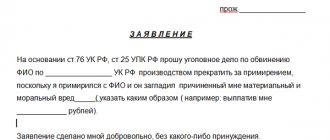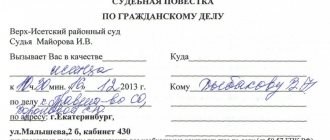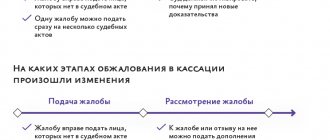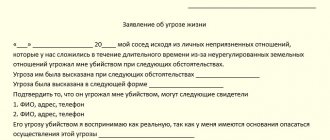In accordance with the Criminal Code of the Russian Federation, a threat to life and health is classified as a serious violation, for which the person who has become its victim has the right to demand not only that the guilty person be brought to criminal responsibility, but also that he be punished according to the severity of the consequences (neurosis, insomnia, mental disorder) compensation for moral damage.
In this article, we will tell you what can serve as a legal basis for filing a complaint with the police about a threat to life and health, how to draw it up correctly, what documents to attach to it, and what consequences to expect after filing it.
Multi-channel free hotline Legal advice on criminal law. Every day from 9.00 to 21.00
Moscow and region: +7 (495) 662-44-36
St. Petersburg: +7 (812) 449-43-40
The legislative framework
The procedure and extent of prosecution for threats of murder and infliction of grievous bodily harm are regulated by Article 119 of the Criminal Code of the Russian Federation.
If the person against whom the threats are made has reason to believe that they may come true, he will be able to ensure that the perpetrator is subject to one of the following penalties:
- Restriction of freedom for a term of up to 24 months, administrative arrest for a term of 4 to 6 months, imprisonment for a term of up to 24 months.
However, these penalties are imposed provided there are no aggravating circumstances. If they are present, i.e. If it is proven that the threats were voiced for political, racial, national, ideological or religious reasons, the guilty person expects:
- Imprisonment for up to 2 to 5 years + restriction to hold a certain list of government positions + restriction to engage in certain types of business for up to 3 years.
Reasons for filing a police report
In order for a person replete with threats of physical violence or even the death of his victim to be brought to justice as soon as possible according to the gravity of the offense, it is necessary to timely (immediately) report this by contacting law enforcement agencies.
The success of the entire event depends on how quickly and competently this is done. Thus, the primary role is played by the evidence base (audio and video recordings, witness statements, etc.), as well as a correctly drawn up application, which describes in detail all the facts available to the applicant and the materials supporting them.
As for the basis for filing a statement with the police about a threat to life and health, it may be the very fact of voicing threatening statements towards the applicant. However, as practice shows, quite often law enforcement officers refuse to initiate criminal proceedings due to the absence of the following distinctive features:
- A knife, gun or any other object that the aggressor threatens to use against his victim with the aim of causing physical harm;
- The attacker is physically superior to the one he is threatening, and also displays the behavior of a mentally ill person;
- At the moment of voicing his threats, the potential rapist is in close proximity to the object of his threats, while he attempts physical pressure (presses him against the wall, throws him to the floor, covers his mouth with his hand, etc.).
Thus, when deciding whether to declare a threat, one should be guided by the presence in a particular situation of one or more distinctive features from the above list. At the same time, you need to understand that each situation is unique, and therefore you should make a final decision on the advisability of filing a statement about a threat to life and health to the police, relying primarily on your own opinion.
It is also necessary to determine whether there was only a threat of violence, or whether the aggressor made an attempt on his life, in other words, tried to kill him. In the first case, the incident is limited to a verbal altercation with fragments of physical violence (hit with a hand, pushed), in the second, the attempt to kill is interrupted by the intervention of bystanders or law enforcement officers.
Since the punishments for these crimes are strikingly different, they should be interpreted as accurately and intelligibly as possible.
Evidence of a threat
In accordance with Article 119 of the Criminal Code “Threats of Murder”, criminal proceedings regarding threats to the life and health of a citizen are initiated in a private-public manner, i.e. based on a statement from the victim. Therefore, the responsibility for collecting evidence rests entirely with him.
In order to bring a criminal to justice, it is necessary to collect sufficient evidence to confirm his guilt. They can be:
- Photocopies of correspondence via SMS, instant messengers or social networks, which contain fragments with death threats;
- Audio recordings (by phone or tape recorder) in which you can hear the aggressor threatening his opponent with physical harm;
- Video recordings, the content of which is similar to the content of audio recordings, but which also have visual evidence of potential violence (attempt to hit, beating);
- Photographs of threats captured on a wall, paper or other surface;
- Eyewitness testimony (if any).
How to prove the presence of a threat of murder or grievous bodily harm?
As stated in Art. 74 of the Criminal Procedure Code of the Russian Federation, evidence in a criminal case is any information on the basis of which the court, prosecutor, investigator, inquirer establishes the presence or absence of circumstances to be proven in criminal proceedings, as well as other circumstances relevant to the criminal case.
In other words, the victim has the right to submit to the court factual data on the basis of which the presence or absence of a crime, the motives for the crime, circumstances affecting the degree and nature of the responsibility of the accused, as well as other circumstances characterizing the personality of the accused, the nature and extent of the damage caused by the crime will be established. etc.
In 2021, the following will be accepted as evidence in a threat case:
- Expert opinions;
- Testimony of the victim;
- Testimony of witnesses (virtually any persons can become witnesses in a criminal case, with the exception of those listed in Part 2 of Article 56 of the Code of Criminal Procedure of the Russian Federation);
- Audio and video materials (for example, voice recordings or recordings from city surveillance cameras);
- Recordings of telephone conversations (you can record threats over the phone using free smartphone applications)
- SMS messages or emails (if threats come in the form of messages or comments, it is recommended to take screenshots and have them certified by a notary).
Drawing up an application
If you receive regular and completely plausible threats, the only sure way out is to immediately contact the police. In order for the submitted application to be considered urgently, without delay or replies, you should treat the preparation of the application with maximum responsibility and attention.
When contacting the police, you can report a threat either verbally or in writing. In the first case, the duty officer will record everything stated by the applicant independently, and then generate an appeal, which will then be registered and forwarded for consideration to an authorized employee.
When drawing up an application yourself, you can do it either by hand, on an A4 sheet, or electronically, on a computer. The electronic version of the application is considered the most convenient and complete, since it is initially structured as competently as possible, and therefore, at the end, the police officer will have in his hands all the information necessary for a comprehensive investigation of the situation.
Regardless of the format of the threat statement, it must contain the following sections:
- A cap. It contains the full name of the institution to which the application is submitted (in this case, a police department), the details of the head of the department (last name, first name, patronymic, position held), to whose name the written appeal is submitted, details of the injured party (last name, first name, patronymic , address of permanent, temporary or actual residence, contact telephone number);
Between the introductory and main parts the title of the document is written, namely, “Statement of a threat to life” or “Statement of a threat to kill.”
- Main part. Here, in a business style, the essence of filing an application is described, the actions of the person from whom the threats were received are described, how they were accompanied, where, when and in the presence of whom they occurred, what materials confirm this, what laws justify the accusations made;
- Requirements. Here, referring to specific articles of the Criminal Code of the Russian Federation, a request is made to law enforcement officials, namely, to organize an investigation into the fact of the submitted application and bring the guilty person to justice;
- Final part. It, in the form of a list, lists all the materials available to the applicant that prove the guilt of the accused person and confirm all the facts and circumstances stated in the main part.
- At the very end, the date of filing the application to the police is indicated, as well as the applicant’s personal signature and a transcript to it.
After submitting the application to the police, within the next 10 days after that it is subject to careful study; based on the information received, an inspection, inquiry and other events will be organized, which will subsequently determine the punishment for the accused citizen.
However, in some cases, law enforcement officers may refuse to accept a statement about a threat to life and health. In this case, the application should be submitted again, but to a different authority.
Sample
When should you not file a complaint?
There are 2 main cases when you should not file a complaint with serious structures:
- The microfinance organization did not violate anything.
- You want to try to resolve the dispute peacefully.
In the first case, you will waste your time - the answer from the government organization may come in a month, and it will not give you anything (and the penalty will increase during this time). In the second case, it is better to write a letter directly to the microfinance organization, and not to the Central Bank or the prosecutor's office - if a government agency comes to a microcredit organization with an inspection based on your tip, you can forget about the peaceful resolution of the conflict.
Institutions of appeal
As a rule, most statements regarding received threats are submitted to the police at the place of permanent, temporary or actual residence. Unfortunately, sometimes these attempts are not crowned with success, and the application, due to the lack of compelling reasons and aggravating circumstances, is returned to the citizen who submitted it.
In addition, quite often, statements about a threat or attempt on life are perceived as a false denunciation, and therefore remain ignored. If you find yourself in such a situation, you can resolve it by contacting one of the following authorities:
- Prosecutor's Office;
- Ministry of Internal Affairs. The most convenient way to submit an application to this body is to use the official State Services portal.
An application to the prosecutor's office is drawn up according to the same procedure as an application to the police. In this case, a standard form for drawing up a standard document form is used as a sample. To make filling out easier, you can use a sample downloaded freely available on the Internet.
An electronic appeal submitted through the State Services portal requires preliminary registration on the website, and only after that – the preparation and sending of the appeal.
If the accusation is confirmed to be false, the applicant who reported the threats he received will be prosecuted under Article 306 of the Criminal Code of the Russian Federation “False denunciation”, as a result of which he will be forced to pay a fine of up to 120 thousand rubles or up to 24 months in prison.
Liability for insult to personality
First you need to figure out what responsibility insulting a person entails. Previously, there was a criminal article for such a violation.
At the moment, there is only administrative liability for insulting a person.
Article 5.61 of the Code of Administrative Offenses contains the following sanctions for insulting a citizen:
- humiliation of the dignity and honor of a person, expressed in an indecent manner, is punishable by a fine: for individuals - from one to three thousand rubles, for legal entities - from fifty to one hundred thousand rubles;
- insult in the public space, as well as in the media: for citizens - from three to five thousand rubles, for organizations - from one hundred to five hundred thousand rubles;
- inaction in case of public insult, as well as insults in the media: for officials - from ten to thirty thousand rubles, for organizations - from thirty to fifty thousand rubles.










